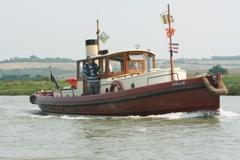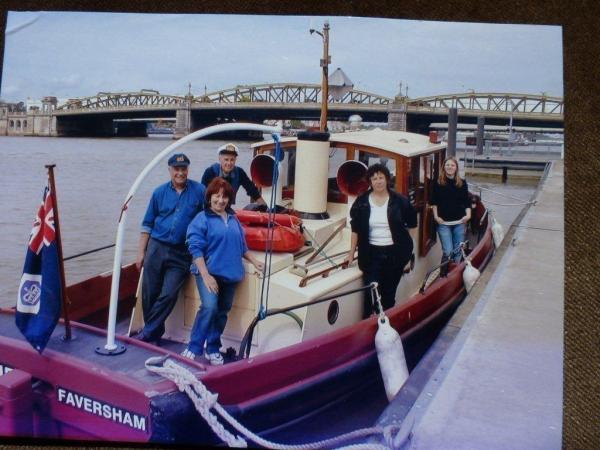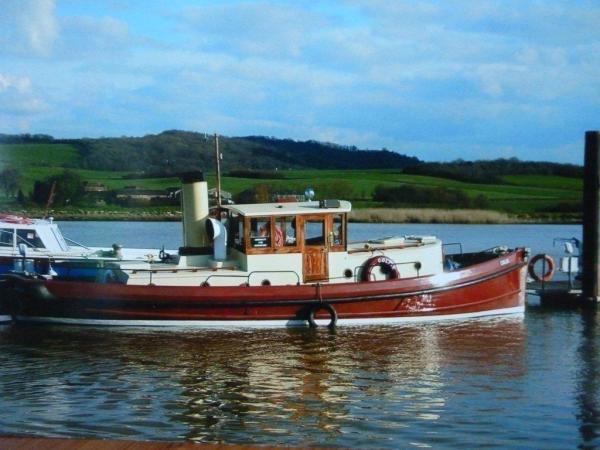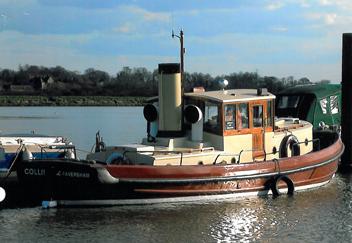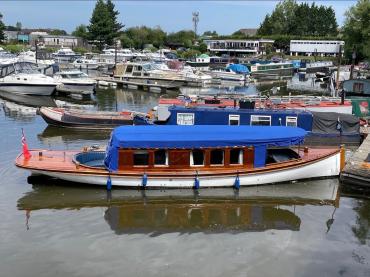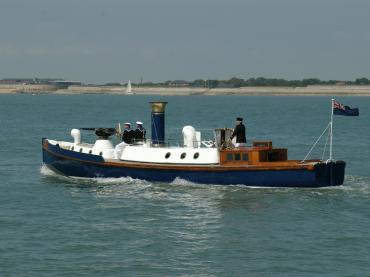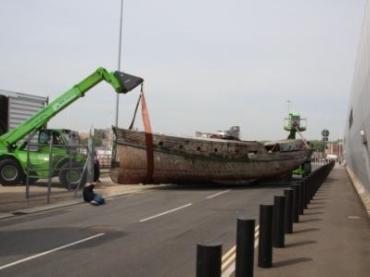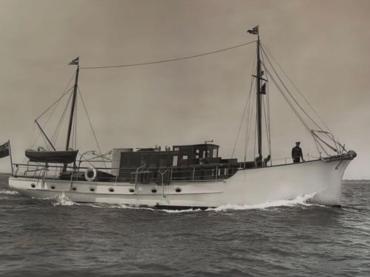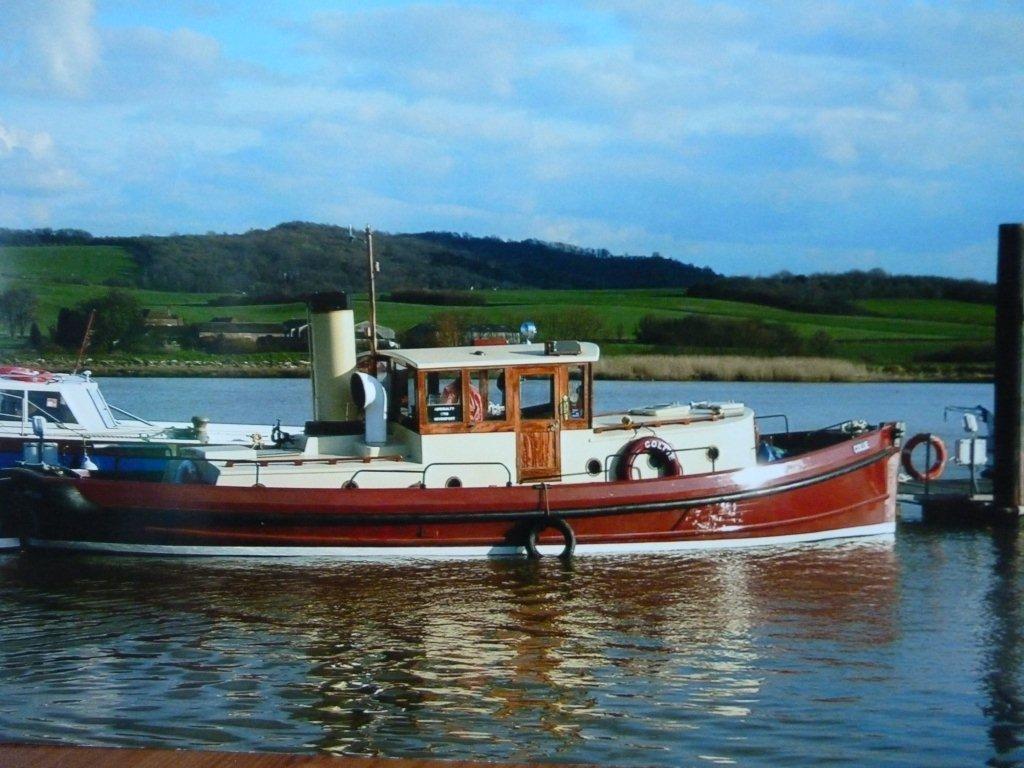
Details
Construction
Dimensions
History
COLLIE was built circa 1890 by Thornycrofts as a sailing pinnace for the Royal Navy. She was condemned in 1926, but was later re-designed and re-keeled to serve as a tug, before being converted to a fire boat during World War Two.
As a sailing pinnace during the First World War, COLLIE was on general duties in Devonport Naval Dockyard. With 16 oars, two masts with bowsprit she was more than capable of helping ships to anchor, and to manoeuvre and transport crews from ship to shore. With her double diagonal planks hull construction (teak on oak) she was a heavy, tough workboat
It was in this guise that she was sunk in 1942 by the Luftwaffe in Plymouth, whilst serving with HMS HERMES. Again, she was condemned, but was re-instated into active service with the torpedo base, HMS DEFIANCE. She was finally decommissioned by the Navy in 1950. Later, COLLIE became a personal launch and was converted by Terry Young at Oare Creek, Faversham between 1997 and 2003.
In 2006, she was certified in A1 condition and was known to be sailing in the Thames estuary area.
In 2013, COLLIE is being used by skipper Paul Woodhead for Hon. Medway Port Pilot duties through Imray's East Coast Pilot.
Significance
1. What is the vessel’s ability to demonstrate history in her physical fabric?
Evidence for designs, functions, techniques, processes, styles, customs and habits or uses and associations in relation to events and people. How early, intact or rare these features are may impact on significance.
COLLIE was built circa 1890 by J I & Co Thornycroft as a sailing pinnace for the Royal Navy and was designated Admiralty pinnace number 7356. She was of double diagonal carvel construction using pitch pine/elm on oak frames. She is a 36ft monohull, and is fully decked with a flat stern. COLLIE was condemned in 1926, but was later re-designed and re-keeled by Rogers & Co at Plymouth where she was fitted with her first paraffin engine. She was re-commissioned as an Admiralty towing tug and given the number 1760. She was converted to a fire boat during World War Two and later became a personal launch following works by Terry Young at Oare Creek, Faversham between 1997 and 2003. She was fitted with her third engine, a Ford 4-cylinder diesel engine, in 2002 and re-launched in 2003.
2. What are the vessel’s associational links for which there is no physical evidence?
Associations with people or places. Off-ship research.
COLLIE is nationally significant for the role she played in both World Wars - during the First as a sailing pinnace on general duties in Devonport Naval Dockyard, then during the Second as a fire boat when she was sunk in 1942 by the Luftwaffe whilst serving the aircraft carrier HMS HERMES. She was re-instated into active service at the torpedo base, HMS DEFIANCE and was finally decommissioned by the Navy in 1950. In 2012, she was selectxed to take part in the Queen's Diamond Jubilee Pageant and, the following year, she was used for Hon. Medway Port Pilot duties through Imray's East Coast Pilot. COLLIE is significant for being the oldest surviving Royal Navy pinnace and one of only two surviving sailing pinnaces (the other being CARETTA, built in 1898 by the Admiralty at Devonport). She is said to have been the only Admiralty boat to have been condemned three times. She has been recorded on the National Register of Historic Vessels since 2009.
3. How does the vessel’s shape or form combine and contribute to her function?
Overall aesthetic impact of the vessel, her lines, material she was built from and her setting. Does she remain in her working environment?
The primary function of COLLIE was as a sailing pinnace for the Royal Navy. With 16 oars, two masts and a bowsprit she was more than capable of helping ships to anchor, and to manoeuvre and transport crews from ship to shore. Her hull was heavily built since she was designed to be used as a tough workboat. Despite her various conversions she retains the general appearance of a pinnace, but her current configuration is that of a personal launch following conversion for private use in the late 1990s. COLLIE remains in operational use at Faversham, Kent.
Source: NHS-UK team, 10 May 2016.
This statement was developed as part of the Heritage Lottery funded First World War project. http://www.ww1britainssurvivingvessels.org.uk/
Key dates
-
2009
A Sustainability Award of £100 for a banner was made from the Strategic Development Fund of National Historic Ships
-
2012
Vessel selected for Queen’s Diamond Jubilee Pageant
-
2012
CBS televised River Pageant from COLLIE which publicised vessel in USA. CBS also spent some time filming the vessel at the National Maritime Museum, where she is the subject of the 'Sea & Me' project
Grants
-
September 2009
A Sustainability Award of £100 for a banner was made from the Strategic Development Fund of National Historic Ships
Own this vessel?
If you are the owner of this vessel and would like to provide more details or updated information, please contact info@nationalhistoricships.org.uk

